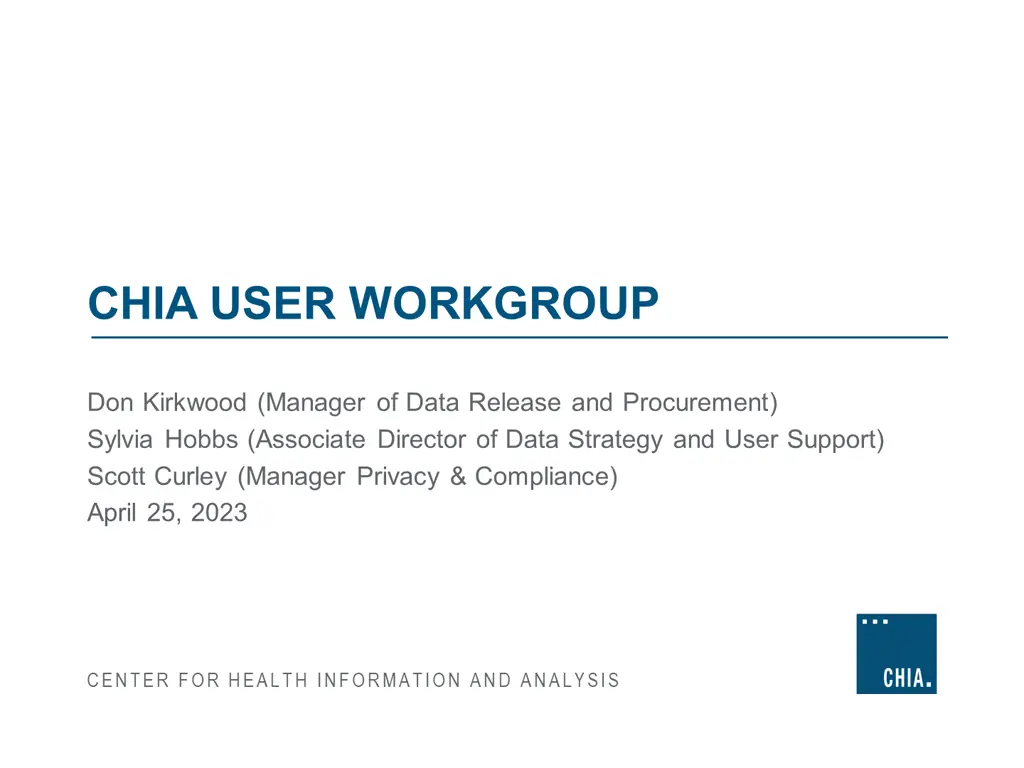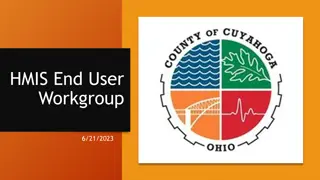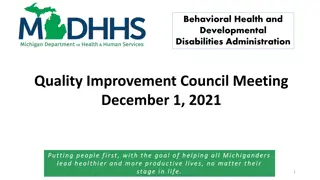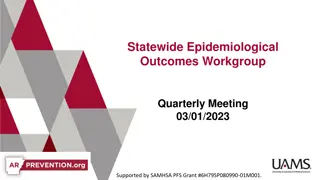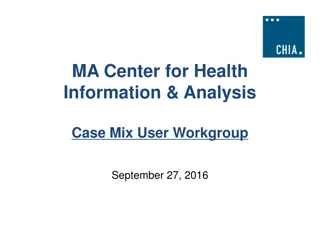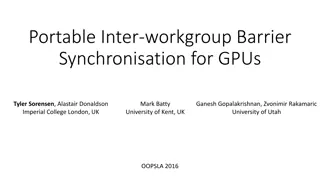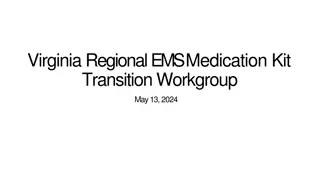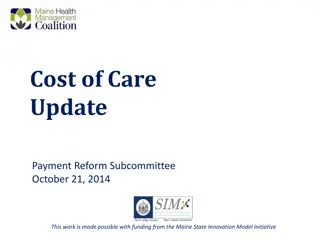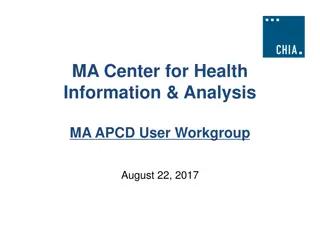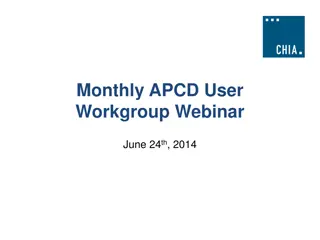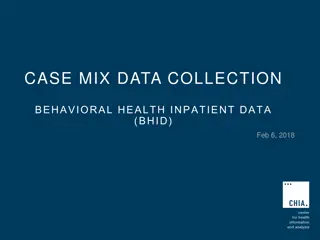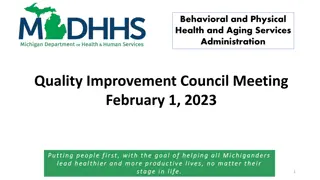CHIA USER WORKGROUP
Stay up-to-date with the latest updates on APCD data releases, case mix projections, website updates, user support, and more.
Download Presentation

Please find below an Image/Link to download the presentation.
The content on the website is provided AS IS for your information and personal use only. It may not be sold, licensed, or shared on other websites without obtaining consent from the author.If you encounter any issues during the download, it is possible that the publisher has removed the file from their server.
You are allowed to download the files provided on this website for personal or commercial use, subject to the condition that they are used lawfully. All files are the property of their respective owners.
The content on the website is provided AS IS for your information and personal use only. It may not be sold, licensed, or shared on other websites without obtaining consent from the author.
E N D
Presentation Transcript
CHIA USER WORKGROUP Don Kirkwood (Manager of Data Release and Procurement) Sylvia Hobbs (Associate Director of Data Strategy and User Support) Scott Curley (Manager Privacy & Compliance) April 25, 2023 CENTER FOR HEALTH INFORMATION AND ANALYSIS
Agenda Announcements: APCD Release CY 2021 Updates FY21 Case Mix Release Projections Website Updates User Support Questions Hospital Recorded Blood Alcohol Levels ICD-10-Codes for Family and Social Disruption Comparison of Case Mix to MA APCD Hospital Identifiers Q&A 2 User Workgroup | CHIA User Support
MA APCD CY 2021 Available for request Applicants with approved projects that require updated APCD data (CY 2021 Data) should submit to CHIA a completed Exhibit B (Certificate of Continued Need and Compliance) of the Data Use Agreement. After submitting a completed Exhibit B you will receive an invoice (if applicable) for the requested data. Upon payment of the invoice the order for the data will be placed. CY 2021 Data includes data on services from January 2017 December 2021 with six months of claim runout. 3 User Workgroup | CHIA User Support
Case Mix FY21 Release *CURRENT* RELEASE TIMEFRAMES FOR EACH FILE: Inpatient (HIDD) Available for request Emergency Department (ED) Available for request Outpatient Observation (OOD) Applicants with approved projects that require newly available year(s) of Case Mix Data (e.g., FY 19) should submit to CHIA a completed Exhibit B (Certificate of Continued Need and Compliance) of the Data Use Agreement. After submitting a completed Exhibit B you will receive an invoice (if applicable) for the requested data. Upon payment of the invoice the order for the data will be placed. Available for request 4 User Workgroup| CHIA User Support
Website Release Updates Updates on the production of APCD and Case Mix databases and status of data requests are now posted to CHIA s website! Aim #1 is to provide weekly or bi-weekly status update on CHIA data products as they are in development. Aim #2 is to provide applicants with information about expected fulfillment status for individual data requests. Request IDs will be communicated to Data Requestors via email. Please visit http://www.chiamass.gov/status-of-data-requests/ to see the current status of releases. User Workgroup| CHIA User Support 5
Question Question: The latest Centers for Disease Control and Prevention underlying cause of death data for : The latest Centers for Disease Control and Prevention underlying cause of death data for Massachusetts indicates a 38% increase in the age Massachusetts indicates a 38% increase in the age- -adjusted death rate from alcohol from calendar year 2019 to 2020. The FY2016 implementation of ICD from calendar year 2019 to 2020. The FY2016 implementation of ICD- -10 add specific nomenclature for gradients of blood alcohol levels. To what extent are the new blood add specific nomenclature for gradients of blood alcohol levels. To what extent are the new blood alcohol gradient codes being used in the Case Mix data? alcohol gradient codes being used in the Case Mix data? ICD-10-CM Codes for Blood Alcohol Levels adjusted death rate from alcohol- -induced causes 10- -CM included an update to CM included an update to induced causes Answer: There are eleven new ICD-10-CM Y90 codes referencing blood alcohol levels. Nine of the codes include specific gradients for blood alcohol levels. See Table 1 below. The codes are being used in the outpatient emergency department (ED) visit data. The volume of patients with blood alcohol codes trended upward in FY2018, with more than twice the number of males than females having blood alcohol codes. See Figure 1 below. Table 1. ICD-10-CM Codes for Blood Alcohol Levels ICD-10-CM Code Y90 Y90.0 Y90.1 Y90.2 Y90.3 Y90.4 Y90.5 Y90.6 Y90.7 Y90.8 Y90.9 Description Evidence of alcohol involvement determined by blood alcohol level Blood alcohol level of less than 20 mg/100 ml Blood alcohol level of 20-39 mg/100 ml Blood alcohol level of 40-59 mg/100 ml Blood alcohol level of 60-79 mg/100 ml Blood alcohol level of 80-99 mg/100 ml Blood alcohol level of 100-119 mg/100 ml Blood alcohol level of 120-199 mg/100 ml Blood alcohol level of 200-239 mg/100 ml Blood alcohol level of 240 mg/100 ml or more Presence of alcohol in blood, level not specified Figure 1. FY2016 to FY2021 Volume of Emergency Department Visits by Sex with Recorded Blood Alcohol Level 15,502 16,500 15,061 14,365 14,089 14,500 13,345 12,351 12,500 Females 10,500 Males 8,500 7,374 7,276 6,784 6,551 6,515 5,818 6,500 4,500 FY2016 FY2017 FY2018 FY2019 FY2020 FY2021 continued
ICD-10-CM Codes for Blood Alcohol Levels Answer (continued): The higher rate of males with recorded blood alcohol levels in ED data aligns with the higher rate and upward trend in alcohol-induced deaths for males in Massachusetts. See Figure 1 below. While both the Massachusetts male and female alcohol-induced age-adjusted death rates per 100,000 trended upward, the death rate for males remains lower than the national rate for males. See Figure 2 below. However, at the height of the pandemic in calendar year 2020, the alcohol-induced death rate for Massachusetts females surpassed the national rate for females. See Figure 3 below. Figure 1. Massachusetts Age-Adjusted Alcohol-Induced Death Rate by Sex per 100,000 19 17 15 13 Male 11 Female 9 Linear (Male) 7 5 3 1 1999 2000 2001 2002 2003 2004 2005 2006 2007 2008 2009 2010 2011 2012 2013 2014 2015 2016 2017 2018 2019 2020 2021 Fig. 2. Comparison of Massachusetts to National Death Rate for Males* Fig. 3. Comparison of Massachusetts to National Death Rate for Females* Age-Adjusted Rate per 100,000 Age-Adjusted Rate per 100,000 MA Males U.S. Males MA Females U.S. Females 21 9 8 Massachusetts male alcohol-induced death rate remains lower than the national death rate for males Massachusetts female alcohol-induced death rate surpassed the national death rate for females in the single calendar year of 2020 19 7 17 6 15 5 13 4 11 3 9 2 7 1 1999 2000 2001 2002 2003 2004 2005 2006 2007 2008 2009 2010 2011 2012 2013 2014 2015 2016 2017 2018 2019 2020 2021 1999 2000 2001 2002 2003 2004 2005 2006 2007 2008 2009 2010 2011 2012 2013 2014 2015 2016 2017 2018 2019 2020 2021 continued *Source: Centers for Disease Control and Prevention, National Center for Health Statistics. National Vital Statistics System, Mortality Data on CDC Wonder
Answer (continued): When analyzing ICD-10-CM blood alcohol levels, keep in mind that the ICD-10-CM Y90 codes for blood alcohol levels are reported in either the associated diagnosis field or the external cause field, not in the principal diagnosis field. Over the past six years (FY2016-FY2021), the top emergency department principal diagnoses for those tested for alcohol levels were alcohol abuse with intoxication and alcohol dependence with Intoxication. For those who did not have a principal diagnosis of alcohol abuse or dependence, head injuries were the leading anatomic trauma associated with high blood alcohol levels, chest pains were the leading physiologic disorder, and major depression the leading psychiatric disorder. See Table 1 below. Each year since ICD-10-CM implementation, on average 20,839 patients have ED recorded blood alcohol level and consistently, each year, the most frequent recorded level on over 40% of patients tested was the highest blood alcohol level of 240 mg/100 or more. See Figure 1 below. ICD-10-CM Codes for Blood Alcohol Levels Table 1. FY2016 FY2021 Top ED Non-Alcohol Principal Diagnoses with Recorded Blood Alcohol Levels Rank 1 2 3 4 5 Anatomic Injuries Physiologic disorders Chest pain Other chest pain Syncope and collapse Nausea with vomiting Epigastric pain Psychiatric/Behavioral Disorders Major depressive disorder Suicidal ideations Anxiety disorder Altered mental status Other psychoactive substance abuse Unspecified injury of head Laceration without foreign body of scalp Laceration without foreign body of other part of the head Contusion of other part of head Abrasion of other part of head Figure 1. FY2016 FY2021 Most Frequent Alcohol Level of Patients with ED Recorded Blood Alcohol Level 45.1% 48.8% 46.6% 47.9% 45.5% 50% 42.0% 40% 30% 20% 10% 0% 2016 2017 2018 2019 2020 2021 Blood alcohol level of less than 20 mg/100 ml Blood alcohol level of 20-39 mg/100 ml Blood alcohol level of 40-59 mg/100 ml Blood alcohol level of 60-79 mg/100 ml Blood alcohol level of 80-99 mg/100 ml Blood alcohol level of 100-119 mg/100 ml Blood alcohol level of 120-199 mg/100 ml Blood alcohol level of 200-239 mg/100 ml Presence of alcohol in blood, level not specified Blood alcohol level of 240 mg/100 ml or more continued
ICD-10-CM Codes for Blood Alcohol Levels Answer (continued): As with the outpatient ED visit data, a higher volume of males in the inpatient hospital care setting have recorded blood alcohol levels, paralleled by the same pronounced FY2019 increase in overall testing volume. See Figure 1 below. However, when comparing the age distribution of patients with recorded blood alcohol levels by care setting (ED vs Inpatient) for the six-year period of FY2016 through FY2019, the age distribution for females has a higher proportion of younger patients than does the male age distribution. See Figure 2 below. The inpatient hospital care setting has a higher proportion of older patients for both males and females compared to the ED visit care setting. See Figure 3 below. Figure 1. FY2016 to FY2021 Volume of Inpatient Hospitalizations by Sex with Recorded Blood Alcohol Level 11,406 12,500 10,969 10,652 10,653 9,925 10,500 8,628 8,500 Females 6,500 5,135 Males 4,815 4,750 4,679 4,438 3,798 4,500 2,500 FY2016 FY2017 FY2018 FY2019 FY2020 FY2021 Figure 2. Figure 3. Age Distribution of ED Visit Patients with Recorded Blood Alcohol Level Age Distribution of Inpatient Discharges with Recorded Blood Alcohol Level FY2016-FY2021 FY2016-FY2021 85+ 85+ 80 - 84 80 - 84 Higher proportion of older patients 75 - 79 75 - 79 70 - 74 70 - 74 65 - 69 65 - 69 60 - 64 60 - 64 55 - 59 55 - 59 Male Male 50 - 54 50 - 54 45 - 49 45 - 49 Female Female 40 - 44 40 - 44 35 - 39 35 - 39 30 - 34 30 - 34 25 - 29 25 - 29 20 - 24 20 - 24 Higher proportion of younger females 15 - 19 15 - 19 0 - 14 0 - 14 0% 2% 3% 5% 6% 8% 9% 11% 12% 14% 15% 17% 0% 2% 3% 5% 6% 8% 9% 11% 12% 14% 15% 17%
Question Question: I am applying for ED visit data to study the emotional/social sequelae of the pandemic on families, : I am applying for ED visit data to study the emotional/social sequelae of the pandemic on families, such as the impact of loss of a loved one. I previously used ICD such as the impact of loss of a loved one. I previously used ICD- -9 9- -CM V health status to study forms of family disruption and wanted to determine whether the newer ICD health status to study forms of family disruption and wanted to determine whether the newer ICD- -10 health status codes are consistently being used in the outpatient emergency department visit data. health status codes are consistently being used in the outpatient emergency department visit data. Disappearance and Death of a Family Member CM V- -codes on factors influencing codes on factors influencing 10- -CM CM Answer: Yes, there are granular ICD-10-CM Z-codes for family life disruption (See Table 1 below) and social life disruption (See Table 2). Hospitals are using these codes to report on factors influencing the health status of patients visiting the outpatient emergency. For example, even though there has been a 21% decrease in overall ED Visit volume from 2016 to 2021, the volume of patients whose health status was impacted by the disappearance and loss of a family member (ICD-10-CM Z634) has more than tripled. See Figure 1 below. Table 1. ICD-10-CM Codes for Family Life Disruption Table 2. ICD-10-CM Codes for Social Life Disruption ICD-10-CM Z633 Z6331 Z6332 Z634 Z635 Description Absence of family member Absence of family member due to military deployment Other absence of family member Disappearance and death of family member Disruption of family by separation and divorce Other stressful life events affecting family and household Stress on family due to return of family member from military deployment Alcoholism and drug addiction in family Other stressful life events affecting family and household Other problems related to primary support group, including family circumstances Problems in relationship with spouse or partner ICD-10-CM Z600 Z608 Z602 Description Problems of adjustment to life-cycle transitions Other problems related to social environment Problems related to living alone Target of (perceived) adverse discrimination and persecution Acculturation difficulty Problems related to social environment Social exclusion and rejection Problem related to social environment, unspecified Z605 Z603 Z60 Z604 Z609 Z637 Z6371 Z6372 Z6379 Z63 Z630 600 482 Figure 1. FY 2016 FY2021 Increase in Emergency Department Visits with ICD-10-CM Code Z634 for Disappearance and Death of a Family Member 500 ED Visit Volume 400 325 315 300 241 189 200 119 100 2016 2017 2018 2019 2020 2021
Provider IDs Question Question: The Case Mix data has organization identifiers for facilities. Can those same : The Case Mix data has organization identifiers for facilities. Can those same identifiers be used in the MA APCD to identify the parallel claims data associated with identifiers be used in the MA APCD to identify the parallel claims data associated with the hospital submitters in the case mix data? the hospital submitters in the case mix data? Answer: No, the case mix hospital organization identifiers are facility IDs assigned by CHIA and are not used in the MA APCD. However, the case mix data does include the physician license number assigned by the Massachusetts Board of Registration of Medicine. The MA APCD Provider filing specifications does contain a field for License ID (PV06) which insurance carriers are ask to report the state license number for the provider identified in the Plan Provider ID field (PV002). For a physician, this is the medical license for a non-doctor this is the practice license. It is important to keep in mind that the Plan Provider ID is not always for a person but can be persons, facilities or other entities involved in claims transactions. The license ID reported in the Case Mix data is only for persons, not facilities. While both hospitals in the MA APCD and in Case Mix data contain the same facility names, the facility names are standardized in the Case Mix data. In the MA APCD, one carrier's data might include the full name of a facility while another carrier might abbreviate that name. Therefore, the MA APCD facility names are not reported in a standardized fashion across all carriers. FACILITY SITE COMPARISON DATA MA APCD CASE MIX SHARED HIPAA Taxonomy to Classify Provider Specialty Type of Bill on Facility Claims CMS Assigned National Provider IDs Site of Service on NSF/CMS 1500 Claims Federal Tax ID Facility License ID Organization IDs Assigned by CHIA for : Hospital Site Hospital Filer (if the not same as Site) Transferring Hospital Facility Name Address City State ZIP Code
Where can I find past User Workgroup Presentations? http://www.chiamass.gov/ma-apcd-and-case-mix-user-workgroup- information/ 13 User Workgroup | CHIA User Support
When is the next User Group meeting? The next User Group will meet Tuesday May, 23. http://www.chiamass.gov/ma-apcd-and-case-mix-user-workgroup- information/
Resultant Research Using CHIA Data https://www.chiamass.gov/resultant-research-using-chia-data
Questions? Questions related to MA APCD: apcd.data@chiamass.gov Questions related to Case Mix: casemix.data@chiamass.gov REMINDER: Please include your IRBNet ID#, if you currently have a project using CHIA data. 16 User Workgroup | CHIA User Support
